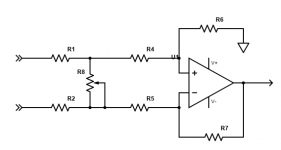I am testing a INA1620 evaluation board and I am curious what the proper way to implement a volume control is while keeping a balanced input signal? The feedback resistors are contained in the chip. Most headphones amp schematics are using a unbalanced input and a inverting/non-inventing architecture. This appears to be a differential amplifier with balanced inputs. Thanks for any advice! 
Here is a link to the data sheet: https://www.ti.com/lit/ug/sbou205/sbou205.pdf?ts=1624905466258

Here is a link to the data sheet: https://www.ti.com/lit/ug/sbou205/sbou205.pdf?ts=1624905466258
Last edited:
I am testing a INA1620 evaluation board and I am curious what the proper way
to implement a volume control is while keeping a balanced input signal?
Use two more precision series input resistors, with one variable shunt resistor between them.
Attachments
Last edited:
Use two more precision series input resistors, with one variable shunt resistor between them.
Excuse my ignorance, but is this the proper way to perform volume control? I have read this sort of attenuation can effect the source (and the input of the amp) because it changes impedance. Thanks.
Most sources are voltage output, with a very low source impedance.
The extra series resistors are of the same value as the internal ones.
In any event, the input impedance of this circuit is no less than that of the original circuit
(without the three extra parts), since the op amp input is a virtual ground (in this case,
that means both inputs are at the same signal potential).
The extra series resistors are of the same value as the internal ones.
In any event, the input impedance of this circuit is no less than that of the original circuit
(without the three extra parts), since the op amp input is a virtual ground (in this case,
that means both inputs are at the same signal potential).
Last edited:
